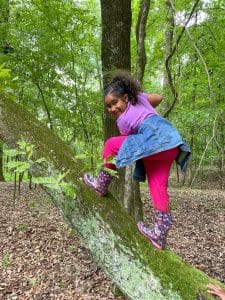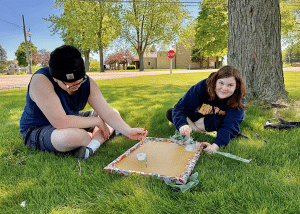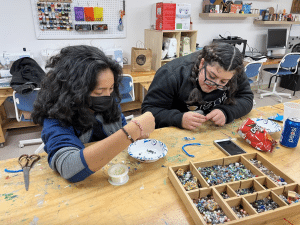Competency-Based Learning: Emphasizing Life Skills, Reflection, and Proficiency
CompetencyWorks Blog
Education Reimagined has been working to research and elevate what makes the learner-centered approach successful while also elevating the broader field. Although different models and organizations have their own language, many of the concepts overlap as we all work to improve learning outcomes for young people. We’re more alike than we are different. We identified five key elements that can be seen across many learner-centered environments: learner-agency; socially-embedded; personalized, relevant, and contextualized; open-walled; and competency-based. In this two-part series, we’ll explore how these elements come to life in learner-centered environments across the United States.
Of our five elements, competency-based learning directly connects with the Aurora Institute competency-based education definition, particularly the following three aspects:
- Assessment is a meaningful, positive, and empowering learning experience for students that yields timely, relevant, and actionable evidence.
- Students progress based on evidence of mastery, not seat time.
- Rigorous, common expectations for learning (knowledge, skills, and dispositions) are explicit, transparent, measurable, and transferable.
While television’s Moira and David Rose hit a bubbling, burning roadblock on Schitt’s Creek when neither knew what it meant to “fold in the cheese,” viewers knew it wouldn’t have mattered if the cheese was stirred, mixed, swirled, or incorporated in some other manner, as long as it was in the sauce at generally the right time. With a competency-based approach, the path to success can often look different as long as an understood goal is achieved.
But how does competency-based learning look beyond the kitchen and in various learning environments?

In many learner-centered environments, receiving credit for learning is based on an individual’s learning goals and focuses on demonstrating a learned skill or concept. For instance, at The Lab School of Memphis, learning that occurs through internships is credited through an evaluation by the industry mentor and a self-assessment by the learner. In a six-week internship, the first three weeks are spent learning about the industry and the internship role, with a consistent cadence of feedback. Then, for the remaining three weeks, learners have more independence as they complete a project related to and useful for their internship site, and learners present these projects to their industry mentor. The assessments in these scenarios are not necessarily about getting the “right” answer. Instead, they are about showing how the learner thinks, listens, communicates, and approaches challenges that are embedded in real-life contexts.

A host of competency-based assessment frameworks also exist, such as the International Big Picture Learning Credential (IBPLC), which is used at LaFayette Big Picture and other Big Picture Learning network schools internationally. This tool is based on Big Picture Learning’s six frames of learning: personal qualities, quantitative reasoning, empirical reasoning, social reasoning, communication, and knowing how to learn. As learners plan and complete projects throughout the year, they work with their advisor to ensure that their projects have elements that can help them achieve each of these competencies. For example, a young person who wants to learn about becoming a chef might explore measurement conversions to achieve a quantitative reasoning competency and spend time front-of-house learning customer service skills to earn a communication competency. Learning will look different based on what is being learned, but this tool is utilized to verify that learning is being effectively measured and credentialed.

The focus in many learner-centered environments is the application of real-world knowledge over grades and test scores. Norris School District helps learners who might be missing credit within the conventional school system by assisting them through “credit acceleration.” If a learner is not yet proficient in specific areas, a learning design architect from Norris will work with an internship mentor to see how the experience can help the learner earn credit once they demonstrate their experience with a competency or subject area. While it could seem like any experience would easily check a box, the relational nature of learner-centered education helps to ensure that the learning is authentic. When learners feel respected and valued, they are often highly receptive to feedback from educators, their advisor, and mentor. If a learner cannot accurately show the development of a skill, staff will work with the learner until they figure out how to authentically demonstrate that competency. Many learners also experience self-discovery moments about how they learn and how to set goals as they move through the process, supported by mentors.
One learner from FabNewport in Rhode Island recalled a time when she had a mishap with the site’s laser cutter—a very costly piece of equipment. After she had spent several months working with an educator to learn how to use the laser cutter, she was free to use it on her own. Even with her training, she once made the mistake of not checking the files correctly. Due to this, the cutter went over the same section of wood over and over again, eventually starting a small fire. Instead of getting in trouble or being banned from using the equipment, the learner debriefed with the FabNewport team to understand what went wrong and how to avoid similar situations in the future. By taking a “hey, stuff happens” approach rather than a punitive one, a culture of openness and exploration was cultivated. After all, if mistakes are not allowed, a huge part of the learning process may be missed. In this case, the learner was able to move beyond this accident and is now selling the laser-cut bookmarks she created in local businesses throughout the Newport area.

Although the types of knowledge and skills may differ, each site has an established process to credential learning. While it might not look like a conventional report card, learning environments can credential young people’s skills and share their progress with families, districts, future employers, or colleges. With confidence, young learners can proudly share the competencies they have developed—skills that will carry over, in a variety of ways, throughout their lives.
You can read more about Education Reimagined’s five key elements of learner-centered education in the “Learner-Centered in Focus” report. Stay tuned for part two, where we’ll explore the remaining four elements of our definition of learner-centered education and how they connect to the Aurora competency-based education definition.
 Jason Krobatsch is Education Reimagined’s Senior Manager of Content Development, bringing a decade of experience in communications, including five years in education. Passionate about amplifying learner-centered innovation, he has helped elevate the stories of over 100 educators, young people, and thought leaders working to create a public education system that serves today’s youth. When he’s not wordsmithing, you can find him listening to a podcast, watching ice hockey, enjoying a Broadway show, or sitting around a campfire with friends.
Jason Krobatsch is Education Reimagined’s Senior Manager of Content Development, bringing a decade of experience in communications, including five years in education. Passionate about amplifying learner-centered innovation, he has helped elevate the stories of over 100 educators, young people, and thought leaders working to create a public education system that serves today’s youth. When he’s not wordsmithing, you can find him listening to a podcast, watching ice hockey, enjoying a Broadway show, or sitting around a campfire with friends.